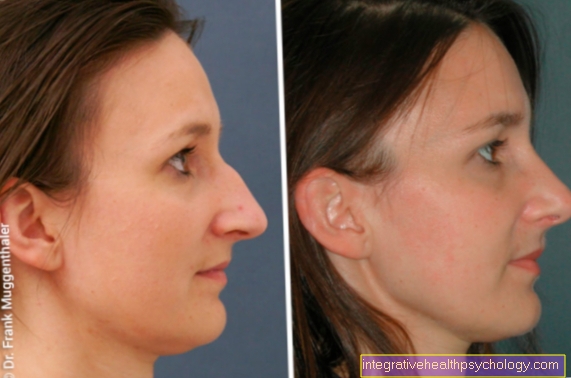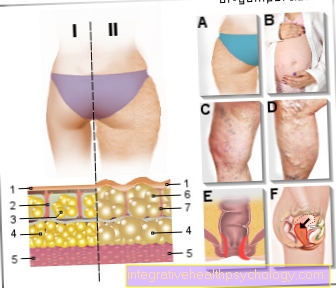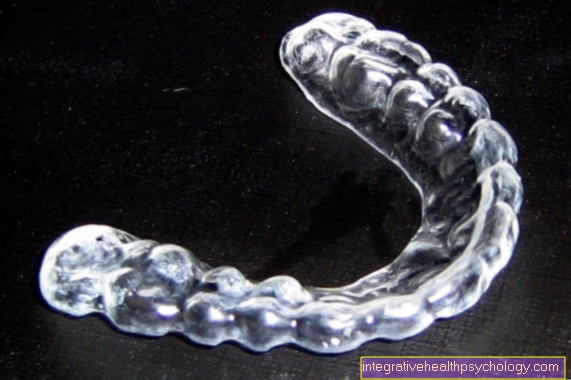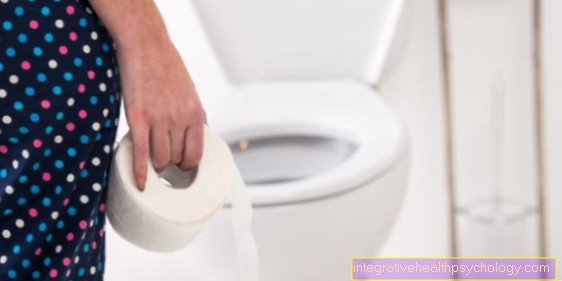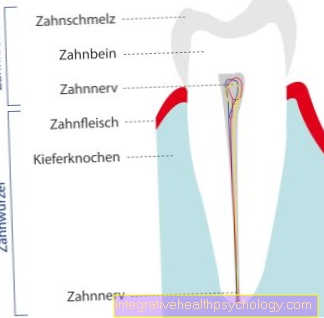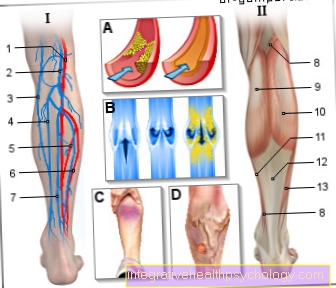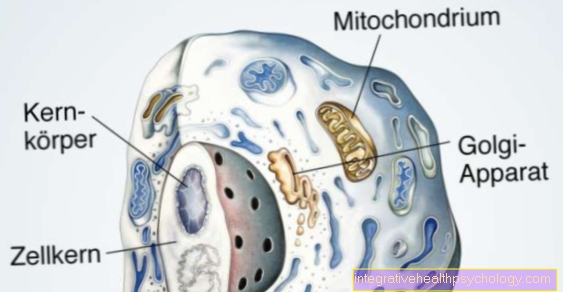Fistula on the anus
General
The anus
The words anus and anus can be used interchangeably. Both designate the outlet opening of the intestinal canal of higher living beings, to which humans belong.
In humans, the anus consists of the so-called anal canal (Canalis analis), which in turn is divided into three zones. In addition, there is a muscular part of the anus, which together with the mucous membrane, skin and other structures forms the contingency organ.
The muscular part is made up of two important muscles, namely the inner (Internal anal sphincter muscle) and the outer (External ani sphincter muscle) Sphincter muscle. The external sphincter can be controlled arbitrarily by humans, so that the bowel movement can be held back or induced. The internal sphincter, on the other hand, is not controlled arbitrarily and is to be understood as strengthening the intestinal muscles.

The fistula
The term fistula is derived from the Latin word fistula which means pipe or pipe. This describes the structure of a fistula quite well. This is because it is a tubular connection between two hollow organs or between a hollow organ and the body surface, which does not exist in the normal state.
A distinction is therefore made between an internal (between two hollow organs) and an external (between a hollow organ and the body surface) fistula. In addition, a lip fistula can be distinguished from a tubular fistula based on the microscopic structure.
For more information about fistulas in the genital area, read our article: Fistula in the genital area - everything you should know
The anal fistula
ICD-10 classification? K60.3. Anal fistula; K60.4 rectal fistula; K60.5 anorectal fistula
Fistulas on the anus, too Anal fistulas or Perianal fistulas called, are inflammatory changes in the anal regionwho have different Layers of skin can affect.
Of the Anal abscess provides the acute form the disease, whereas the Anal fistula the chronic form the disease is.
Classification
There are two different classifications for fistulas on the anus.
First of all, it can be divided into an incomplete and a complete form according to its scope. The incomplete anal fistula arises from an infection of a certain gland in the anal region (proctodeal gland). An abscess can result from it. The complete anal fistula can arise from a spontaneous (perforation) or operative opening of an anal abscess.
The second classification is based on the anatomical course of the fistula. One speaks of the division into parks. According to this classification, a distinction is made between the intersphincteric, extrasphincteric, submucosal, transphincteric, subcutaneous and suprasphincteric fistula. These terms refer to the anatomical position of the fistula in relation to the sphincter muscles (sphincters) and the different layers of the skin and connective tissue. An anorectal fistula extends far into the rectum (rectum).
You might also be interested in: Fistula duct
causes
The most common cause of fistulas on the anus are smaller abscesses in the area of the so-called Anal crypts. Crypts you have to like small indentations in the mucous membrane imagine. These abscesses can then depending on the location break into the proctodeal glands mentioned above. Depending on the location of the glands will be different proportions the mucous membrane as well as the inner and outer sphincter muscles.
When this abscess is spontaneously or through a surgical opening emptied outwards or inwards, a Anal fistula. It is possible that then on the skin of the anus The ducts of these fistulas can be seen are. But you can too to the side of the mucous membrane be located (inside).
Other causes of fistulas on the anus are inflammatory bowel disease. However, this is far rarer causes. These diseases include Crohn's disease, Ulcerative colitis, Diverticulitis and cryptitis. Also Cancers of the gastrointestinal tract probably play a role in the development of anal fistulas.
Symptoms
In contrast to abscesses, fistulas cause somewhat weaker complaints. During abscesses through strong pain, fever and general weakness can make noticeable, this is usually the case with fistulas. not the case.
Anal fistulas are expressed by a constant wetting, which the patients call very uncomfortable feel. It usually falls through Soiling of clothes on. Additionally secrete fistulas pus and can bleed every now and then. Those affected also notice this very quickly when Change of underwear.
Light pain, a Stabbing and pulling can also occur. If the fistula is very large, it is possible that chair about their external duct singled out becomes. However, this is less often the case.
diagnosis
The Finding a fistula takes place through the inspection, Palpation (Palpation with digital rectal examination) and the Rectoscopy (Rectoscopy).
Upon inspection, it can turn out to be difficult prove to find the anal fistula. Usually one shows up small execution passagethat is slightly below the skin level. You can only find it partly through that Spreading the anal skin. But a fistula can also like a little wart look with secretions or pus escaping from pressure.
To find the internal and external fistulous duct (especially with complex courses) a MRI of Pelvic floor be helpful.
Also the so-called Probing is used to get a closer look at the spatial conditions to get the fistula. A probe is inserted into the fistula.
Differential diagnostic is the anal fistula of one Perianal thrombosis or one Hemorrhoid prolapse to delimit.
Which doctor is responsible for this?
If you suspect you have a fistula on your anus, it is best to look for your own first Family doctor on. This can usually confirm the suspicion and make the diagnosis. In addition, he issues a referral for the responsible specialist.
In the case of a fistula on the anus is a Proctologist or a surgeon to seek out. Often fistulas are treated in surgical centers in which doctors work with the additional designation “proctology”. This sub-area deals with diseases of the rectum, rectum and anal canal. Also a Dermatologist is not wrong as the first point of contact, as he too can recognize a fistula in the anus and make suggestions on how to proceed.
therapy

The Therapy of a fistula takes place surgically because a Spontaneous healing actually does not occur. Various methods are used for this.
1. The fistulotomy
The fistula will split in this process. The tissue that lies between the fistula duct and the anal canal is severed. One helps oneself different probesthat are placed in the fistula duct. Straight superficial fistulas let yourself be so very good and almost complete Treat without relapse or complications.
Still it can postoperatively to continence disorders that are a serious complication. The more material the sphincter muscle is cut through, the higher it is Risk of this consequence. The intervention can be performed in Local anesthesia be made. The opened fistula is then left to open wound healing.
2. The thread drainage
Also with the Spring drainage it is a frequently used procedure in the treatment of anal fistulas. It will be there different threads and techniques used. The goal of this procedure is that Drain the pus from the fistula. It takes place in front of you, for example plastic fistula closure or if the risks are too high for that Cutting out a fistula Application.
The first technique is called "Loose spring drainage". Your goal is to drain the pus in the long term and get one Closure of the external opening of the fistula to prevent. After removing the thread, the fistula becomes the Spontaneous healing left.
The second method is the fibrosing thread. The goal is to fibrosis the fistula. A fibrosis is that Conversion of the organ tissue into connective tissue, the fistula becomes so to speak "Drained". The procedure is with one certain risk of continence disorder afflicted. It is mainly used at high fistulas applied before a plastic reconstruction.
The last procedure is called "Cutting Seton" or "Cutting thread". According to recent studies, this procedure has one unacceptably high risk of continence disorder and will therefore no longer recommended. The aim of the procedure is to separate the parts of the sphincter lying in front of the fistula duct and the Evacuation of the purulent area.
3. The plastic closure
Plastic closure of an anal fistula is used when a radical removal of the fistula is not possible due to an unfavorable location or size. It will 5 different procedures differed, but which basically pursue the same goal and are similar in principle. The inner opening of the fistula (inner ostium) becomes in the rectum closed with a seam. Stabilization then takes place with a flap of different origins. It can also be a Closure of the inner opening of the fistula without additional tissue lobes.
The plastic procedures are established therapy options with a 60-80% healing chance. They differ in theirs Cure rate not significant from each other, but have different high risk of complicationsthat the patient needs to be informed about.
4. Fibrin glue
The fistula duct is first cleared and then filled with a fibrin glue. The fibrin glue is a biological product. Fibrin is a proteinthat at the Blood clotting plays an important role. This procedure is usually used only in special cases applied.
5. Anal fistula plug
Of the Anal fistula plug is also a biological product out Small intestine components of the pig. It becomes the Closure of the fistula suitable and also serves as a Basis for growth for the body's own tissue, so that it is gradually replaced by it. It represents another treatment option for high fistulas represent.
6. Thermal fistula closure technique
The fistula is caused by heat destroyed and locked.
Fistula on the anus in the baby
Babies too can have a fistula on their anus, that too as operated on in adults becomes. Without treatment there is a risk of one abscess forms, which in the worst case leads to a Blood poisoning (Sepsis). Most often, parents notice the fistulas in their children as a kind of swelling or pimple on the bottom. Pus can also evacuate when pressure is applied. In babies, the wounds heal very well after the operation and the children do not remember the event.
Risks and Complications
In general it can be with these surgical procedure to Wound healing disorders and Bleeding come.
The Smoke has a negative effect postoperative complications and should therefore be avoided.
The main complication is one Continence disorders, for example at the Fistulotomy can occur. Continence disorders occur primarily further severing of the sphincter muscles on. Hence this should spared as possible become.
Healing time
A fistula on the anus takes time to heal individually very different. It depends on various factors. These include the general health of the person affected, the type of fistula and the type of treatment. Patients with a Weakness of the immune system or additional diseases, for example one inflammatory bowel disease, usually need a longer time for a good healing.
The The type of fistula is also very important. Simple fistulas that do not affect the sphincter heal much more easily and are much easier to treat than complex fistulas that also affect the sphincter.
A general Healing time of several weeks and months is on average normal and to be expected. However, the exact duration cannot be given as a flat rate.
forecast
At complete fistula splitting is the prognosis pretty good. At very branchy and complicated Gradients, can Recurrences occur.
Summary
Fistulas on the anus are a common illnessthat above all young men concerns.
These are the main factors that play a role in diagnosis Patient talk (Anamnesis), the clinical examination as well as the operational sounding and Staining of the fistula duct a crucial role. This can be done with very complicated processes MRI and the Endosonography can also be used.
Therapy for an anal fistula is operational, where the The sphincter is spared as much as possible should be. Superficial fistulas can be splitbut not the rest. Just at high anal fistulas sphincter-sparing procedures should be used. Depending on the procedure, type of fistula, previous illnesses and others existing risk factors, increases the risk for Continence disorders after the operation. This complication is common in anal surgery generally given and should also be taken into account here.
Further topics from this area

Abscess on the buttocks
A cavity filled with pus is called an abscess. An abscess on the buttocks can develop as part of inflammatory processes and requires medical treatment.
Here you get to the topic: Abscess on the buttocks

Anal abscess
An abscess is a cavity that is filled with pus. Abscesses in the anal area are mostly based on a previous inflammatory process.
Here you get to the topic: Anal abscess

